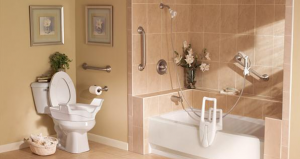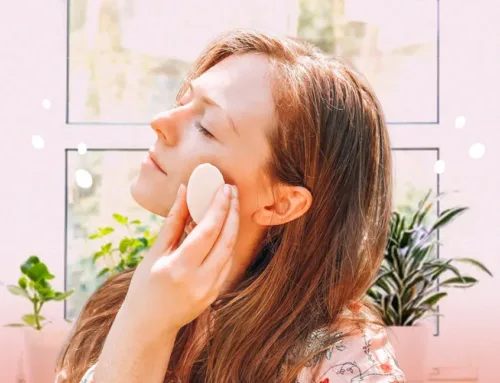The bathroom may be the smallest room in your house, but for some family members, it can be the biggest danger zone in the house.

The smallest room in the house is also, for many people, the most dangerous room in the house. With slippery floors and little space to move around, the bathroom can be a true danger zone for anyone with mobility or balance issues. However, unlike most dangers in the world, this problem is relatively easy to solve. With the right equipment and safety measures, bathrooms can be made safe for everyone, including the more fragile members of your family, such as aging parents.
Since regular bathrooms can be a danger to your loved ones, it is important to make your bathroom safe and accessible – even if they only visit on occasion. After all, you don’t want your elderly mother saying, “I hate going to my daughter’s house, because her toilet seat is too low and it’s so hard to get off the toilet!”
Below are some simple steps that can and should be taken to make your bathroom comfortable, convenient and safe for yourself and your family.
General Safety
First off, you want make sure your bathroom does not pose any risk of entrapment. Individuals who suffer from arthritis may have difficulty using regular doorknobs, so make sure your doorknobs are large enough that they can get in and out of the bathroom alone.
In addition, if your loved one is not fully independent and is likely to have difficulties while using the bathroom, consider installing a call button as well as leaving the door unlocked whenever he or she is using the bathroom. Always have disposable gloves available in case the person needs your help while he or she is using the bathroom or taking a shower.
The best kind of bathroom for someone who is disabled is a bathroom that is large enough to accommodate a walker or wheelchair, but if it isn’t, be sure to have conveniently-placed grab bars around the room – they can be really helpful in getting up and around the bathroom safely.
Toilet Safety
Most elderly people – especially those with arthritis and other mobility or flexibility issues – can benefit from the installation of a raised toilet seat, which makes it easier to get on and off the toilet seat. Some toilet seat risers are equipped with side rails which helps the user stay steady on the toilet. It is also very important to install a grab bar or two near the toilet so there is something to hold onto when getting off the toilet seat.
Bathroom Floor Safety
The significance of the state of the bathroom floor is often overlooked, but in fact, it is one of the primary causes for falls in elderly people. Since bathroom tiles are likely to get wet and slippery, special care must be taken to ensure that the floor stays dry at all times. One surprising way that the floor may become temporarily slippery is from spraying air freshener – so if air freshener is needed, make sure to only spray above the toilet seat.
Bathtub Safety
Bathtub and shower floors are even more likely to cause falls, so a shower mat or a shower chair may be necessary, in addition to grab bars on the bath walls.
Getting over the side of the bathtub is another difficulty – and danger – present in most typical bathrooms. To avoid this issue, you can install a walk-in shower or a specially designed bathtub with a low opening. Another option is a transfer bench, which allows people with low mobility to move from a wheelchair or chair to a shower chair without having to get up and step over the high ledge. You can also use a bathtub safety rail, which is clamped onto the bathtub edge to allow independent individuals to climb into the bath more easily.
Remember, different situations and different weaknesses call for different products and precautionary measures, so always consult an expert or an experienced reseller to find the best ways to make your bathroom safe for your family and loved ones.
Disclaimer: No information presented on this website or in this bathroom safety guide is medical advice or intended as a substitute for the advice of a physician. All information on this website concerning medical conditions is from publicly available sources.



